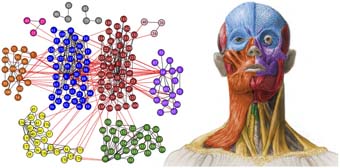
A new mathematical analysis tool developed by researchers from the Theoretical Biology Group at the Cavanilles Institute of Biodiversity and Evolutionary Biology of the University of Valencia has allowed a deeper understanding of the anatomy of the human head thanks to describing the skull as an extended network structured in ten modules. The results of this study led by researcher Diego Rasskin Gutman have been published in the latest issue of the 'Scientific Reports journal', published by 'Nature'.
Scientists at the University of Valencia have developed a research methodology called Anatomical Network Analysis (AnNA), based on network analysis mathematical tools for studying anatomy. More precisely, this method has been developed over the last six years, as a result of the findings of the doctoral thesis by Borja Altava Esteve, under the supervision of Rasskin. Thanks to the high degree of abstraction of AnNa, researchers have been able to conduct several studies of both the human skeleton and of the rest of terrestrial vertebrates, especially as regards the development and evolution of the skull.
INTEGRATION OF MUSCLES AND CARTILAGES
On this occasion, for the first time ever, the Theoretical Biology Group added the head muscles and cartilages to the study of the skull bones (including the inner ear bones, the jaw and the bones that connect with head muscles, such as cervical vertebrae and clavicles).
This way, "we found that when analysing the head as a complex system defined by 181 nodes —including bones, muscles and cartilage, and excluding superficial muscles— and 412 physical contacts —sutures and cartilaginous joints—, the system can be subdivided into ten well-defined modules”, says Diego Rasskin.
The Faculty of Medicine at Howard University in Washington D.C. (USA) and the University of Saskatchewan (Canada) have also collaborated in the study by contributing muscular data. Until the publication of this article, the applications of AnNa focused exclusively on bones. As Rasskin explains, each skull "generated a network model in which each bone was represented as the network node and each physical articulation (contact), as a connection. Thus, each skull was modelled as a 0-1 matrix with each connection being a 1. This matrix served to analyse the network attributes, which could in turn be compared to other generic network properties".
DEVELOPMENTAL SEMI-INDEPENDENCE
One of the important findings of this research is also that the functional and developmental dependences of the head as a whole cannot be separated, but are coupled in these ten modules described by scientists at the University of Valencia. "This modular structure allows each module to evolve semi-independently, i.e., changes in one of them has a minimal effect on others", says Rasskin.
By using AnNa, which enables the analysis of bones and muscles at the same time, new cranial functional dependences have been uncovered, because muscles —associated to movements— link separate bones. For example, as the researcher points out, the lower jaw / inner ear module shows dependences between bones associated with masticatory muscles and which would not associate otherwise (jaw to parietal, temporal and occipital) as well as inner ear bones.
Moreover, muscle modules "show left/right independence of orofacial muscles (mouth and face) from the upper face muscles. This allows greater flexibility in facial expression for we are able to move facial muscles on either side separately", he explains.
Diego Rasskin Gutman is a contracted researcher at the General Foundation of the University of Valencia, where he arrived in 2006 to create the Theoretical Biology Group at the Institut Cavanilles thanks to the Ramon y Cajal programme. He teaches the Master’s Degree of Integrative Evolutionary Biology at the University of Valencia and is the editor of Biological Theory. His research interests revolve around evolutionary dynamics, the processes of embryonic development and the relationship between both through formal and mathematical concepts derived from the science of complexity. Rasskin is the author of Chess Metaphors. Artificial intelligence and the human mind, MIT Press (2009) and co-editor of Modularity. Understanding the Development and Evolution of Natural Complex Systems, with a foreword by Herbert Simon, MIT Press (2005) and Pere Alberch. The creative trajectory of an evo-devo biologist, University of Valencia (2009).
Borja Esteve-Altava, Rui Diogo, Christopher Smith, Julia C. Boughner & Diego Rasskin-Gutman (2015) Anatomical networks reveal the musculoskeletal modularity of the human head. Scientific Reports 5, Article number: 8298. doi:10.1038/srep08298
Last update: 17 de february de 2015 11:46.
News release


















